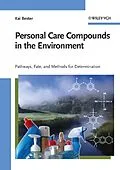Here, the most important classes of toxic chemicals from personal care compounds are systematically covered, from cosmetics to plastics additives to pharmaceuticals. For each substance, data on toxicity and bioaccumulation in various ecosystems are given.
This first comprehensive treatment of personal care environmental toxins is rounded off by a discussion of strategies in wastewater treatment to control and remove these substances.
Autorentext
Kai Bester is Professor for Analytical and Environmental Chemistry at the University of Duisburg-Essen, Germany. He studied chemistry at the University of Hamburg, obtaining his PhD in 1995. Before joining the University of Duisburg-Essen, he worked as a post-doc at the Technical University of Aachen and at the University of Dortmund. Professor Bester's primary research interests focus on the environmental contamination by antibiotics, fragrances and flame retardants as well as pharmaceuticals, and their analysis by mass spectrometric methods.
Klappentext
Personal care items, such as cosmetics, medicines and household products, release a significant amount of potentially harmful substances into the environment. Tracking the sources of these toxic chemicals and their fate in the environment is therefore of prime concern for water and waste treatment authorities and for the manufacturers of such products. This first comprehensive treatment of the topic systematically covers the most important classes of toxic chemicals from personal care compounds, from cosmetics to plastics additives to pharmaceuticals. For each substance, data on toxicity and bioaccumulation in various ecosystems is given.
Following an introduction to sewage treatment plant functions, the book goes on to look at environmental studies and the pertinent analytical chemistry methods. The whole is rounded off by a discussion of strategies in wastewater treatment to control and remove these substances.
Kai Bester is Professor for Analytical and Environmental Chemistry at the University of Duisburg-Essen, Germany. He studied chemistry at the University of Hamburg, obtaining his PhD in 1995. Before joining the University of Duisburg-Essen, he worked as a post-doc at the Technical University of Aachen and at the University of Dortmund. Professor Bester's primary research interests focus on the environmental contamination by antibiotics, fragrances and flame retardants as well as pharmaceuticals, and their analysis by mass spectrometric methods.
Inhalt
INTRODUCTION
General Considerations
An Introduction into Sewage Treatment Plants Functions
ENVIRONMENTAL STUDIES (SOURCES AND PATHWAYS)
Synthetic Fragrance Compounds in the Environment
The Bactericide Triclosan and its Transformation Product Methyl-Triclosan in the Aquatic Environment
UV-Filters
Organophosphate Flame Retardants and Plasticisers
Endocrine Disrupting Agents
Diverse Comounds
ANALYTICAL CHEMISTRY METHODS
Wastewater
Seawater
Sewage Sludges
DISCUSSION
Sewage Treatment Plants
Limnic Samples
Marine Samples
Concluding Discussions
SUMMARY
Titel
Personal Care Compounds in the Environment
Untertitel
Pathways, Fate and Methods for Determination
Autor
EAN
9783527610228
ISBN
978-3-527-61022-8
Format
E-Book (pdf)
Hersteller
Herausgeber
Genre
Veröffentlichung
27.02.2007
Digitaler Kopierschutz
Adobe-DRM
Dateigrösse
6.24 MB
Anzahl Seiten
263
Jahr
2007
Untertitel
Englisch
Unerwartete Verzögerung
Ups, ein Fehler ist aufgetreten. Bitte versuchen Sie es später noch einmal.
